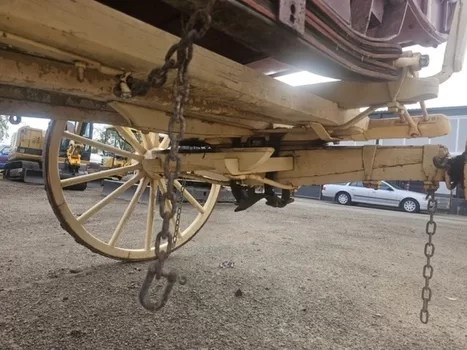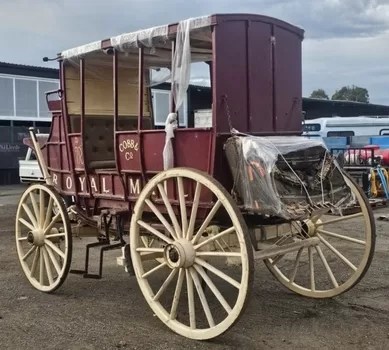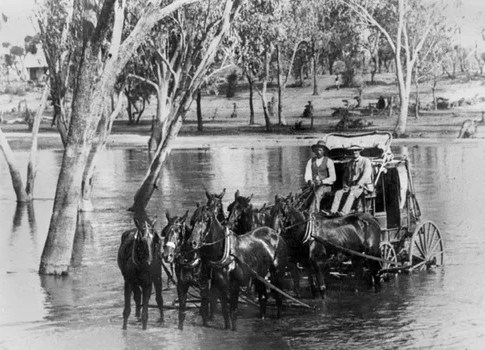In the mid-19th century, as gold fever swept through Australia, the demand for reliable transportation across the vast and rugged landscape surged. Enter Cobb & Co, a name synonymous with pioneering spirit, innovation, and the relentless drive to connect the burgeoning colonies.
This blog delves into the fascinating history of Cobb & Co, their remarkable coaches, its impact on Australian society, and its enduring legacy.
Story continues after this advertisement:
From 1853 to 1924, Cobb & Co was at the forefront of the Australian frontier. What began as a small enterprise grew into the largest and most renowned transport system in the world. Their extensive network spanned from Normanton on the Gulf of Carpentaria to Port Douglas on the Coral Sea, reaching across Victoria and South Australia.

At its peak, Cobb & Co coaches covered 44,800 kilometers per week, utilizing over 30,000 horses.
Cobb & Co Stagecoaches: The Heart of 19th Century Travel
Cobb & Co stagecoaches were the backbone of transportation in 19th century Australia, playing a crucial role in connecting remote communities and facilitating the country’s expansion.
These coaches were more than just vehicles; they were engineering marvels designed to withstand the harsh Australian terrain while providing as much comfort as possible for passengers.
Here’s a detailed look at what these stagecoaches were like:
Cobb & Co coaches: Design and Construction
The stagecoaches used by Cobb & Co were primarily the American Concord coaches, renowned for their durability and innovative design. These coaches were constructed from strong yet flexible timber, such as oak and ash, which provided resilience and the ability to absorb shocks.
The Concord coaches employed a system of leather straps called thoroughbraces, which suspended the coach body between the axles. This thoroughbrace suspension system allowed the coach to sway gently rather than jolt on rough roads, providing a smoother ride over long distances.


While Australian-built stagecoaches incorporated the thoroughbrace technology found in the Concord coach, they were generally smaller, lighter, and more streamlined, offering less passenger space compared to their American counterparts.
The frames of these coaches were reinforced with iron fittings and bands to ensure strength and durability, allowing them to carry heavy loads and endure the tough Australian outback conditions.
Despite their robustness, these coaches were relatively lightweight, which was crucial for navigating rough terrains and reducing the strain on horses.
Cobb & Co coaches: Interior and Capacity
Cobb & Co coaches were designed to maximize passenger capacity and cargo space while maintaining a reasonable level of comfort. Inside, the seating arrangement typically accommodated around 8-14 passengers.
The seats were arranged in three rows: one facing forward, one facing backward, and a middle row with passengers facing each other. This arrangement, while somewhat cramped, made efficient use of space. The seats were padded, though not luxurious by modern standards.


Passengers had to endure long hours on the road, often in uncomfortable conditions, but the thoroughbrace suspension system helped ease some of the discomfort from rough terrain.

Windows were typically fitted with leather blinds that could be rolled up or down to protect passengers from dust and weather while allowing some airflow.
Cobb & Co coaches: Exterior and Features
The roof of the coach and the rear compartment were used for luggage and cargo, which was crucial for transporting mail, gold, and other essential goods, in addition to passengers.
The exterior of Cobb & Co coaches was as functional as it was iconic.
The coaches were often painted in bright colors, with the company’s name prominently displayed. This not only made them recognizable but also added to their visual appeal.
The driver, known as a ‘whip,’ sat on an elevated seat at the front of the coach, often with a guard or assistant who helped manage the horses and protect against potential threats, such as bushrangers.
Depending on the route and terrain, coaches were drawn by teams of four to six horses.
Staging posts were set up along the routes where horses could be changed, ensuring that fresh teams were always available to maintain speed and efficiency.
Given the valuable cargo often carried, including gold, armed guards frequently accompanied the coaches to protect against theft and bushrangers.
1885 Cobb & Co Coach Carrier at auction
With a price guide between $50,000 – $54,000 the coach sold for $91,000 at auction on 29 June 2024.

This authentic Cobb & Co Coach was discovered in a farm shed outside Goulburn in 1962. This historic gem has since been meticulously restored to its original condition and sold at auction through Lloyds Fine Antique Auctions.
The 1885 Cobb & Co Coach Carrier for sale appears to be similar in design and construction to the 1890 Cobb & Co mail and passenger coach made in Charleville, Queensland, housed at the Powerhouse Museum in Sydney.
Rare Original Coaches on Display
Original Cobb & Co coaches are rare and significant pieces of history, and several notable examples are preserved in various collections across Australia:
Concord Coach: Built by the Abbot-Downing Company of New Hampshire and imported by F.B. Clapp and Co around 1869, this coach was used in the Ballarat area. It remains in its original condition and is preserved by Museum Victoria.
Geelong Stagecoach: Possibly built in Geelong, Victoria around 1880, this stagecoach is believed to have been the last mail coach to operate commercially in Victoria in 1916. It is held by Museum Victoria.
Charleville Stagecoaches: Two stagecoaches, numbered 48 and 100, built in Charleville, Queensland in the late 19th century, are part of the National Carriage Collection at the Cobb & Co Museum in Toowoomba.
Powerhouse Museum Stagecoach: Another stagecoach, built in Charleville around 1890, is preserved at the Powerhouse Museum in Sydney.
Nowlands Coach: An Australian-built stagecoach, possibly constructed at the Cobb & Co factory in Charleville in the late 19th century, is in the collection of the National Museum of Australia in Canberra. Known as the “Nowlands Coach,” it was operated by Nowlands Line of Coaches in the Liverpool Plains district.
Kalgoorlie Stagecoach: An Australian-built stagecoach is housed at the Western Australian Museum in Kalgoorlie.
Hay Stagecoach: A locally built stagecoach is on public display in the main street of Hay, New South Wales.
Bathurst Stagecoach: A stagecoach built in Bathurst is on display at the Visitor Information Centre in Bathurst, New South Wales.
Cambridge Downs Stagecoach: A stagecoach is on display at the Cambridge Downs Heritage Display Centre in Richmond, Queensland.
These preserved coaches offer a glimpse into the rich history of Cobb & Co and the vital role they played in connecting communities across Australia.
Only one Concord, or “Jack” coach, of the type imported from the United States by Cobb & Co in the 1850s and 1860s, still survives today.
Step Back in Time at Queensland Museum Cobb+Co in Toowoomba
During August 2024, Queensland Museum Cobb+Co in Toowoomba invites you to step back 100 years to commemorate the final run of the iconic Cobb & Co Coach with four days of festivities.
From August 14th to 17th, the Cobb 100 celebrations will honor a century of horse-drawn transport. Visitors can immerse themselves in the rich history of Cobb & Co with live heritage trade demonstrations, curatorial talks, bush poetry, theatrical performances, and guided tours of the National Carriage Gallery.
The newly refurbished National Carriage Gallery houses Coach No.112, one of the last Cobb & Co coaches to make its final journey on August 14, 1924, along with 49 other horse-drawn vehicles from the Queensland Museum Collection. Celebrate this significant milestone and relive the days when horse-drawn coaches were the lifeblood of transportation. Tickets and information here.
Traveling by Cobb & Co stagecoach
Traveling by Cobb & Co stagecoach was an adventure, marked by the challenges of the Australian landscape. Coaches traversed a variety of terrains, from dusty plains to rocky hills and muddy tracks.
The skill of the driver was paramount in navigating these difficult paths. Staging posts and inns along the routes became vital community hubs where travelers could rest, eat, and exchange news.
Passengers were exposed to the elements, with journeys taking place in all weather conditions. Dust, heat, rain, and cold were all part of the travel experience.

The threat of bushrangers (outlaws) added an element of danger, with armed guards often accompanying the coaches to safeguard passengers and valuables.
Cobb & Co stagecoaches were a remarkable blend of practicality and resilience, tailored to the unique demands of the Australian environment.
They were instrumental in shaping the country’s development, providing a vital link between remote settlements and the rest of the world.
The Birth of Cobb & Co
Cobb & Co was founded in 1853 by four American businessmen—Freeman Cobb, John Murray Peck, James Swanton, and John B. Lamber—who saw an opportunity in the chaotic rush of the Australian goldfields.
Inspired by the American stagecoach systems, they introduced a network of stagecoaches that would revolutionize transportation in Australia. The company’s first route, launched in January 1854, connected Melbourne and the goldfields of Castlemaine and Bendigo.
Innovation and Expansion
What set Cobb & Co apart was their commitment to innovation. They introduced lightweight, sturdy Concord coaches, designed to withstand the harsh Australian terrain.
The company established a series of staging posts along their routes, where horses could be changed and passengers could rest.
The success of the initial routes spurred rapid expansion. By the 1860s, Cobb & Co had extended their network across Victoria, New South Wales, Queensland, and South Australia. They transported not only passengers but also mail, gold, and other essential goods, becoming the lifeline of remote communities.
The Cobb & Co Experience
Traveling with Cobb & Co was an adventure in itself. Coaches typically carried up to 14 passengers, with luggage strapped to the roof and back. The journey was not for the faint-hearted, as passengers endured long hours on bumpy roads, exposed to the elements. Despite these challenges, Cobb & Co coaches were known for their punctuality and reliability.
The company’s drivers were legendary figures, known for their skill and courage. They navigated treacherous roads, braved bushrangers, and battled extreme weather conditions to ensure their passengers and cargo reached their destinations safely.
Challenges and Decline
As the 19th century progressed, Cobb & Co faced increasing competition from the burgeoning railway network. Trains offered a faster, more comfortable means of travel, and the advent of motor vehicles further eroded the demand for stagecoach services. Despite these challenges, Cobb & Co adapted, incorporating motorized vehicles into their fleet and focusing on mail delivery and other services.
However, the decline was inevitable. By the early 20th century, Cobb & Co’s stagecoach services had largely ceased, with the company eventually closing its doors in 1924. Despite this, the legacy of Cobb & Co lived on, celebrated in Australian folklore, literature, and popular culture.
Legacy and Cultural Impact
Cobb & Co’s impact on Australian society was profound. They played a crucial role in the development of the country’s infrastructure, connecting isolated communities and facilitating commerce and communication. Their services helped shape the social and economic landscape of 19th-century Australia.
The company’s legacy is preserved in museums, historical sites, and heritage trails across the country. The Cobb & Co Museum in Toowoomba, Queensland, offers a comprehensive look at the history of the company, featuring original coaches, artifacts, and interactive exhibits.
The museum also hosts regular events, including coach rides and heritage tours, allowing visitors to experience a taste of 19th-century travel.
Cobb & Co’s influence extends to Australian culture, where they are celebrated in stories, songs, and films. Their tale is one of adventure, resilience, and innovation—a testament to the indomitable spirit of the pioneers who helped forge a nation.
Cobb & Co’s story
Cobb & Co’s story is a fascinating chapter in Australia’s history, embodying the spirit of exploration and progress that defined the 19th century. Their pioneering efforts not only transformed transportation but also left an indelible mark on the nation’s identity. As we look back on their legacy, we are reminded of the enduring power of innovation and the relentless pursuit of progress.
So next time you travel across Australia’s vast landscapes, spare a thought for the intrepid travelers of Cobb & Co who paved the way, one dusty road at a time.

The Royal Australian Mint released this $1 Uncirculated Coin in 2024 in honour of the Centenary of Last Passenger Service of Cobb & Co in Queensland.
Related stories
Top 10 Rare Valuable and Collectible Vinyl Records
Luxurious Elegance: Hermés Handbags
Guide to Collecting Vintage Film Cameras
Collecting Kewpie Dolls & Kewpie Cartoons
Police Ephemera ° The value of Victorian reward posters




